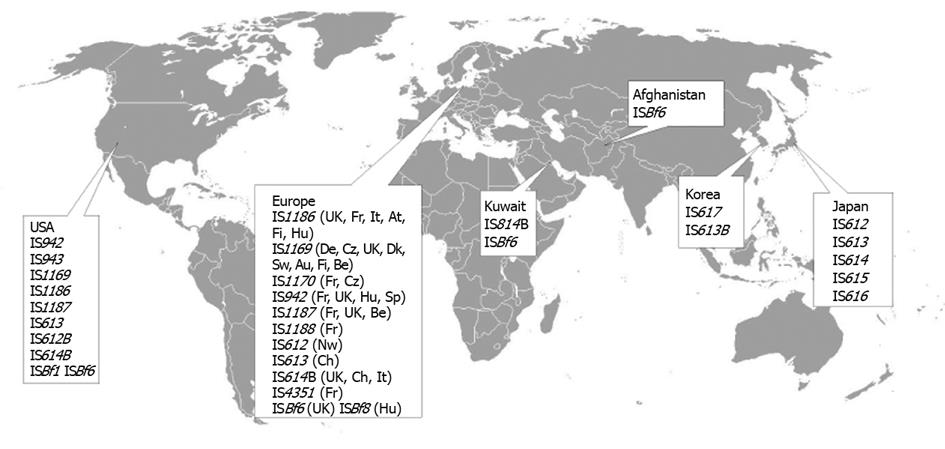Copyright
©2013 Baishideng Publishing Group Co.
World J Clin Infect Dis. Feb 25, 2013; 3(1): 1-12
Published online Feb 25, 2013. doi: 10.5495/wjcid.v3.i1.1
Published online Feb 25, 2013. doi: 10.5495/wjcid.v3.i1.1
Figure 1 Schematic structure of an insertion sequence element.
DR: Direct repeats; IR: Inverted repeats; Po: Outward-oriented promoter; Ptnp: Promoter of the transposase. The transposase gene is denoted as tnp. The borders of the insertion sequence (IS) are indicated by the closed arrowheads below.
Figure 2 Insertion sequence elements found worldwide in antibiotic-resistant Bacteroides isolates.
For Europe, the following abbreviations are used to identify the countries in which the insertion sequences were isolated: At: Austria; Be: Belgium; Ch: Switzerland; Cz: Czech Republic; De: Germany; Dk: Denmark; Fi: Finland; Fr: France; Hu: Hungary; It: Italy; Nw: Norway; Sp: Spain; Sw: Sweden; UK: United Kingdom.
Figure 3 The nucleotide sequences of the promoters of some important Bacteroides antibiotic resistance genes.
The consensus sequence with the conserved regions (A), and the actual promoter sequences (B). The match with the consensus is shown in bold capital letters, proven transcriptional initiation sites are marked in bold with an arrowhead next to them; n denotes any nucleotide, and small letters in the consensus indicate less conserved bases. The own promoters of cepA and cfxA were searched for bioinformatically and are not IS elements next to them in the list. The own promoter sequence of cfiA is from our unpublished preliminary experiments made by ‘rapid amplification of cDNA ends’ capable of amplifying in PCR the 5’ end of the mRNA. Underlined -33 regions are parts of compound promoters and these parts originate only from insertion sequence elements in the cases of these promoters.
-
Citation: Sóki J. Extended role for insertion sequence elements in the antibiotic resistance of
Bacteroides . World J Clin Infect Dis 2013; 3(1): 1-12 - URL: https://www.wjgnet.com/2220-3176/full/v3/i1/1.htm
- DOI: https://dx.doi.org/10.5495/wjcid.v3.i1.1











